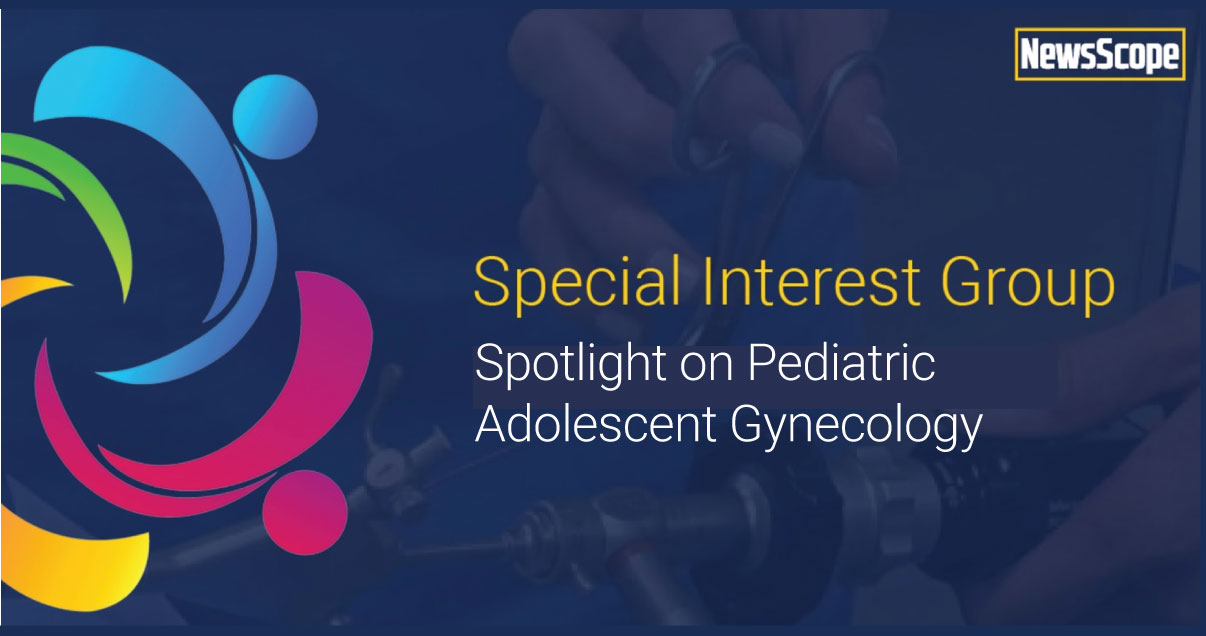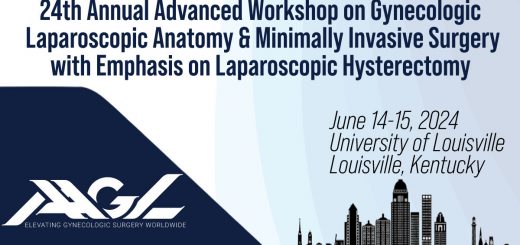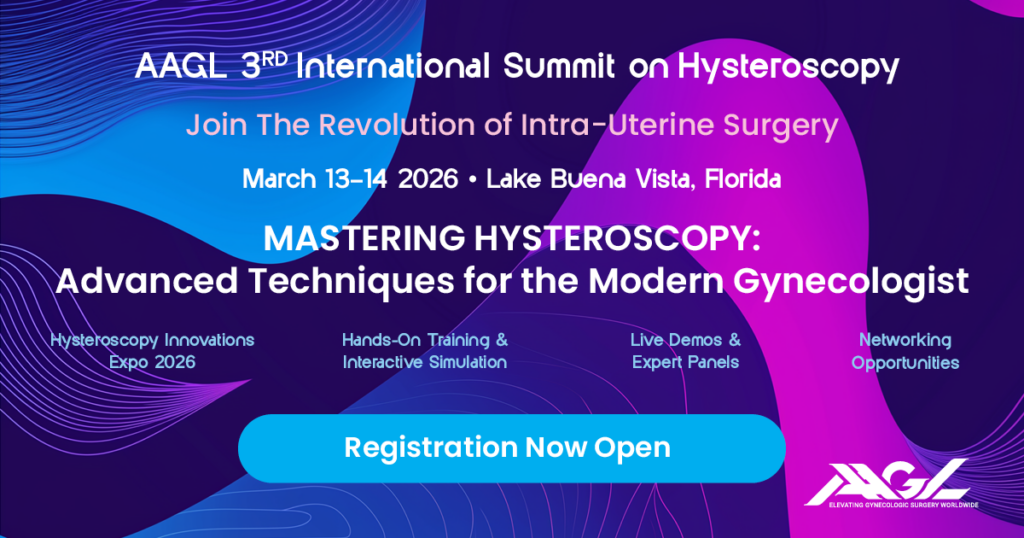Spotlight On: Pediatric and Adolescent Gynecology

This month we cast a spotlight on articles, SurgeryU videos, and Journal of Minimally Invasive Gynecology (JMIG) article recommendations from the AAGL Pediatric and Adolescent Gynecology Special Interest Group (SIG) led by Chair, Krista Childress, MD.
Access to SurgeryU and JMIG are two of the many benefits included in AAGL membership. The SurgeryU library features high-definition surgical videos by experts from around the world. JMIG presents cutting-edge, peer-reviewed research, clinical opinions, and case report articles by the brightest minds in gynecologic surgery.
SurgeryU video recommendations by our SIGs are available for public access for a limited time. The links to JMIG article recommendations are accessible by AAGL members only. For full access to SurgeryU, JMIG, CME programming, and member-only discounts on meetings, join AAGL today!
NEW to SurgeryU
SIG Recommended SurgeryU Video:
Ovarian Tissue Cryopreservation How To With Minimal Electrocautery
by Jessica Long, MD
This video demonstrates a minimally invasive surgical technique used to perform a laparoscopic oophorectomy for the purposes of fertility preservation via ovarian tissue cryopreservation in a prepubertal individual. As the use of oophorectomy for fertility preservation increases, this video provides an example of a way to remove the ovary with minimal energy use, which in turn decreases thermal damage to the ovarian tissue. It also highlights the advancements in the nomenclature related to the ovarian regions and orientation.
Jessica R. Long, MD

Dr. Long is a member of the AAGL PAG SIG and a PAG Surgeon at NIH/Children’s National Hospital in Washington, D.C.
JMIG Article Recommendation #1:
By Parisa HadaviBavili, MSc, Kevser İlçioğlu, PhD, RN, and Yasemin Hamlacı Başkaya, PhD
This review and meta-analysis brings awareness to the various surgical and non-surgical approaches to vaginal creation for patients with MRKH, with special attention to sexual function outcomes and the need for further qualitative and quantitative research on this topic.
JMIG Article Recommendation #2:
How to Manage Endometriosis in Adolescence: The Endometriosis Treatment Italian Club Approach
By Lucia Lazzeri, MD, Karin Louise Andersson, MD, Stefano Angioni, MD, Alessandro Arena, MD, Saverio Arena, Ludovica Bartiromo, MD, Nicola Berlanda, MD, Cecilia Bonin, MD, Massimo Candiani, MD, Gabriele Centini, MD, Simona Del Forno, MD, Agnese Donati, MD, Caterina Exacoustos, MD, Eliana Fuggetta, MD, Luca Labanca, MD, Antonio Maiorana, MD, Francesco Maneschi, MD, Alberto Mattei, MD, Ludovico Muzii, MD, Jessica Ottolina, MD, Alessio Perandini, MD, Federica Perelli, MD, Ida Pino, MD, Maria Grazia Porpora, MD, Valentino Remorgida, MD, Sara Scaramuzzino, MD, Matteo Schimberni, MD, Renato Seracchioli, MD, Eugenio Solima, MD, Michele Vignali, MD, Errico Zupi, MD, and Francesco Giuseppe Martire, MD
This article provides an excellent review on diagnosis and management of endometriosis in the adolescent which is often a delayed diagnosis leading to decreased quality of life.

Emerging and Existing Ablative Surgical Technology for Adolescent Endometriosis Treatment
A new article in the Green Journal highlights the nuances of managing endometriosis in adolescents and key differences from adult women (1). Adolescents may already have signs of endometriosis around menarche. Upon laparoscopic evaluation, nearly 60-70% with dysmenorrhea may have early endometriosis (2-4). Symptoms like heavy menstrual bleeding and non-cyclic pelvic pain, which occurs in 90% of adolescents with endometriosis, may be overlooked (1). Over half have associated gastrointestinal and/or urinary symptoms or a comorbid pain syndrome (6-7).
A thorough history and abdominal exam remain the cornerstone of diagnosis. Ultrasound or MRI may aid in identifying adnexal pathology or reproductive tract anomalies that may suggest concurrent endometriosis (8). Consistent with established ACOG guidelines, a trial of hormonal therapy for 3-6 months should be considered, but laparoscopic evaluation thereafter for refractory symptoms is warranted (9).
On laparoscopic evaluation, adolescents often present with early lesions such as clear vesicles, white implants or petechiae, as opposed to the typical advanced endometriotic lesions found in adults. The few that present with advanced-stage endometriosis may more commonly present with endometriomas over extensive peritoneal disease (10). As such, Shim et al advocate for a more judicious approach to the surgical treatment of endometriosis in adolescents, avoiding the radical resection strategies used more commonly in adults (10). In these cases, ablation strategies can be a helpful alternative with many therapeutic benefits.
Electrosurgery and lasers specifically have an important role in ablation of early endometriosis lesions. Widely available and familiar to endoscopists, monopolar electrocautery set at a low level of 8 Watts provides therapeutic benefit without significant risk of damage to underlying organs (11). In conjunction with monopolar electrosurgery, the argon plasma coagulator can provide superficial fulguration and coagulation of lesions; however, its use is limited in a setting with high intra-abdominal insufflation pressure. Alternatively, the CO2 laser is inexpensive and can be used to vaporize or excise lesions with minimal risk to nearby structures. Other, more expensive lasers that mainly have a tissue coagulation effect are the Nd:YAG, KTP, and holmium lasers, which can take advantage of flexible fibers for increased ergonomics (12).
A new, compact laser diode unit called the TruBlue laser, by A.R.C. Laser Company in Nuremburg, Germany, uses blue light (445 nm wavelength) (Figure 1 & 2). Due to its high absorption in hemoglobin and negligible absorption in water, the TruBlue laser is reported to have improved coagulation capabilities compared to the KTP laser with a low rate of thermal spread (Figure 3) (13). It can deliver up to 4 Watts in a continuous wave or 10 Watts in a pulse wave output. It has a wide beam divergence; therefore, it is important to position close to the tissue for ablative effect to be achieved.
 Figure 1. Transnasal Laryngoscopy with Blue Light Laser (445 nm wavelength) – by Brady Anderson, BS and Henry Hoffman, MD at The University of Iowa Health Care, Department of Otolaryngology.
Figure 1. Transnasal Laryngoscopy with Blue Light Laser (445 nm wavelength) – by Brady Anderson, BS and Henry Hoffman, MD at The University of Iowa Health Care, Department of Otolaryngology.
 Figure 2: TruBlue laser handpiece with 400 µm fiber – by Brady Anderson, BS and Henry Hoffman, MD at The University of Iowa Health Care, Department of Otolaryngology.
Figure 2: TruBlue laser handpiece with 400 µm fiber – by Brady Anderson, BS and Henry Hoffman, MD at The University of Iowa Health Care, Department of Otolaryngology.
 Figure 3. Absorption coefficients of hemoglobin and water with respect to wavelengths of available lasers. Adapted from product information provided by vendor Fortec Medical.
Figure 3. Absorption coefficients of hemoglobin and water with respect to wavelengths of available lasers. Adapted from product information provided by vendor Fortec Medical.
Studies comparing outcomes after ablation versus resection of endometriosis are sparse in adolescents, though radical resection has shown some negative consequences due to extensive adhesive disease post operatively (14). Nonetheless, surgeons have several options for delivering ablative therapy as a safe, alternative approach for endometriosis treatment in adolescents. Early recognition and treatment of adolescent endometriosis allows for minimization of chronic pelvic pain and optimization of their future fertility and quality of life.
References
- Laufer MR, Goitein L, Bush M, Cramer DW, Emans SJ. Prevalence of endometriosis in adolescent girls with chronic pelvic pain not responding to conventional therapy. J Pediatr Adolesc Gynecol 1997;10:199–202. doi: 10.1016/s1083-3188(97)70085-8
- Greene R, Stratton P, Cleary SD, Ballweg ML, Sinaii N. Diagnostic experience among 4,334 women reporting surgically diagnosed endometriosis. Fertil Steril 2009;91:32–9. doi: 10. 1016/j.fertnstert.2007.11.020
- Janssen EB, Rijkers ACM, Hoppenbrouwers K, Meuleman C, D’Hooghe TM. Prevalence of endometriosis diagnosed by laparoscopy in adolescents with dysmenorrhea or chronic pelvic pain: a systematic review. Hum Reprod Update 2013;19:570– 82. doi: 10.1093/humupd/dmt016
- Hirsch M, Dhillon-Smith R, Cutner AS, Yap M, Creighton SM. The prevalence of endometriosis in adolescents with pelvic pain: a systematic review. J Pediatr Adolesc Gynecol 2020;33: 623–30. doi: 10.1016/j.jpag.2020.07.011
- Laufer MR, Goitein L, Bush M, Cramer DW, Emans SJ. Prevalence of endometriosis in adolescent girls with chronic pelvic pain not responding to conventional therapy. J Pediatr Adolesc Gynecol 1997;10:199–202. doi: 10.1016/s1083-3188(97)70085-8
- Dun EC, Kho KA, Morozov VV, Kearney S, Zurawin JL, Nezhat CH. Endometriosis in adolescents. JSLS 2015;19:e2015. 00019. doi: 10.4293/JSLS.2015.00019
- Smorgick N, Marsh CA, As-Sanie S, Smith YR, Quint EH. Prevalence of pain syndromes, mood conditions, and asthma in adolescents and young women with endometriosis. J Pediatr Adolesc Gynecol 2013;26:171–5. doi: 10.1016/j.jpag.2012.12. 006
- Kapczuk K, Zajączkowska W, Madziar K, Ke˛dzia W. Endometriosis in adolescents with obstructive anomalies of the reproductive tract. J Clin Med 2023;12:2007. doi: 10. 3390/jcm12052007
- Dysmenorrhea and endometriosis in the adolescent. ACOG Committee Opinion No. 760. American College of Obstetricians and Gynecologists. Obstet Gynecol 2018;132:e249–58. doi: 10.1097/AOG.0000000000002978
- Shim JY, Laufer MR, King CR, Lee TT, Einarsson JI, Tyson N. Evaluation and Management of Endometriosis in the Adolescent. Obstetrics & Gynecology. 2024 Jan 1;143(1):44-51.
- Laufer MR. Helping “adult gynecologists” diagnose and treat adolescent endometriosis: reflections on my 20 years of personal experience. J Pediatr Adolesc Gynecol 2011;24(Suppl. 5):S13e7.
- Ghosh P, Kochhar PK. A comparative study of the use of different energy sources in laparoscopic management of endometriosis-associated infertility. World Journal of Laparoscopic Surgery. 2013 Dec 1;4(2):89-95.
- Hess MM, Fleischer S, Ernstberger M. New 445 nm blue laser for laryngeal surgery combines photoangiolytic and cutting properties. Eur Arch Otorhinolaryngol 2018;275:1557–1567.
About the Author:
Amitha K. Ganti, MD, FACOG

Dr. Ganti is member of the AAGL PAG SIG and a Clinical Post-Doctoral fellow in the Division of Pediatric and Adolescent Gynecology at Texas Children’s Hospital Baylor College of Medicine in Houston, Texas.

Use of Interventional Radiology and Wire Localization for Septum Resection in a 13-Year-Old Patient With a High OHVIRA
Review:
Obstructed Hemivagina and Ipsilateral Renal Anomaly (OHVIRA) typically manifests as a didelphys uterus with an oblique vaginal septum on the same side as the renal anomaly and often presents around the time of menarche. The oblique septum obstructs menstrual egress from one cervix, leading to hematocolpos and distension of the obstructed hemivagina; thus, treatment of OHVIRA requires resection of the vaginal septum. Septal microperforations can make surgical treatment challenging as the obstructed hemivagina is decompressed, proximal, and difficult to identify. (Image 1)
 Image 1: Drawing depicting high/proximal obstruction (left) versus low/distal obstruction (right) in OHVIRA.
Image 1: Drawing depicting high/proximal obstruction (left) versus low/distal obstruction (right) in OHVIRA.
Case Presentation:
A 13-year-old female with a known absent right kidney presented three years after menarche with dysmenorrhea and irregular menses. Ultrasound and subsequent MRI demonstrated a didelphys uterus, longitudinal/oblique septum, and a minimally dilated obstructed right hemivagina consistent with OHVIRA. (Image 2)
 Image 2: MRI demonstrating two visible cervices (red arrows) with small hematocolpos (yellow arrow).
Image 2: MRI demonstrating two visible cervices (red arrows) with small hematocolpos (yellow arrow).
Exam under anesthesia and vaginoscopy demonstrated a single visible cervix slightly deviated to the left. Intraoperative ultrasound delineated the right hemiuterus and cervix; however, no hematocolpos, distended hemivagina, or microperforations were identified.
Given the inability to identify the exact location of the obstructed hemivagina, resection in typical manner was deferred. She was started on menstrual suppression with norethindrone acetate 5mg orally daily. Interval drainage using interventional radiology was performed with wire localization for septum resection. This was done with the patient in a frog-legged position and a transvaginal ultrasound probe with a needle guide with concurrent cone beam CT guidance fluoroscopy. The transvaginal ultrasound revealed a minimal fluid collection noted in this location which was cannulated with an 18-gauge Chiba needle (Image 3).
 Image 3: Transvaginal needle used for injection of obstructed hemivagina with concurrent direct visualization with transabdominal ultrasound. Tip of needle noted (yellow arrow).
Image 3: Transvaginal needle used for injection of obstructed hemivagina with concurrent direct visualization with transabdominal ultrasound. Tip of needle noted (yellow arrow).
Contrast injection under fluoroscopy and cone beam CT guidance confirmed the position of the catheter within the vaginal collection immediately proximal to the membrane (Image 4).
 Image 4: CT view of catheter placement into the distended hemivagina after injection of contrast.
Image 4: CT view of catheter placement into the distended hemivagina after injection of contrast.
The contrast injection also served to distend the obstructed hemivagina. This needle was then exchanged over Amplatz wire for a 6 French Dawson Mueller pigtail drainage catheter which was left in place and clamped. The patient was then transferred to the operating room, where she was placed in lithotomy position, and the insertion site of the catheter was visualized using vaginal wall retractors. No other microperforation was visualized at this time. Using the catheter as a guide (Image 5), stay sutures were placed on either side of the drain and the septum was incised using electrocautery over the drain, revealing a mix of old, brown blood and injected contrast.
 Image 5: View of catheter traversing the obstructive vaginal septum with lateral stay sutures prior to surgical incision.
Image 5: View of catheter traversing the obstructive vaginal septum with lateral stay sutures prior to surgical incision.
The majority of the remaining septum was excised using Bovie electrocautery, taking care to avoid injury to the cervices and surrounding structures. The vaginal epithelium was oversewn using 3-0 Vicryl sutures to approximate the tissue, and speculum exam confirmed visualization of both cervices.
Ten weeks later, the patient was taken to the operating room for an exam under anesthesia and vaginoscopy, which demonstrated bilateral visible cervices and minimal remaining septum. Image 6 demonstrates the proximity of the level of the septum to the cervix.
 Image 6: Vaginoscopy demonstrating proximity of two cervices (red arrows) and location of excised septum (yellow arrow).
Image 6: Vaginoscopy demonstrating proximity of two cervices (red arrows) and location of excised septum (yellow arrow).
Conclusion:
The resection and repair of OHVIRA can be challenging when the level of obstruction is high with lack of distention to delineate the obstructed hemivagina. Concurrent use of fluoroscopy and ultrasonographic guidance can allow for definitive confirmation of the space and provide a helpful guide for safe repair.
REFERENCES
- Gholoum S, Puligandla PS, Hui T, Su W, Quiros E, Laberge JM. Management and outcome of patients with combined vaginal septum, bifid uterus, and ipsilateral renal agenesis (Herlyn-Werner-Wunderlich syndrome). J Pediatr Surg. 2006 May;41(5):987-92. doi: 10.1016/j.jpedsurg.2006.01.021. PMID: 16677898.
- Kudela G, Wiernik A, Drosdzol-Cop A, Machnikowska-Sokołowska M, Gawlik A, Hyla-Klekot L, Gruszczyńska K, Koszutski T. Multiple variants of obstructed hemivagina and ipsilateral renal anomaly (OHVIRA) syndrome – one clinical center case series and the systematic review of 734 cases. J Pediatr Urol. 2021 Oct;17(5):653.e1-653.e9. doi: 10.1016/j.jpurol.2021.06.023. Epub 2021 Jun 30. PMID: 34274235.
- Yang M, Wen S, Liu X, He D, Wei G, Wu S, Huang Y, Ni Y, Shi Y, Hua Y. Obstructed hemivagina and ipsilateral renal anomaly (OHVIRA): Early diagnosis, treatment and outcomes. Eur J Obstet Gynecol Reprod Biol. 2021 Jun;261:12-16. doi: 10.1016/j.ejogrb.2021.03.018. Epub 2021 Apr 16. PMID: 33873082.
About the Authors:
Sonia Ahluwalia, MD
Lissa Yu, MD


Dr. Ahluwalia is a member of the AAGL PAG SIG and a first year Resident Physician in the department of Obstetrics and Gynecology at the University of Washington in Seattle, Washington.
Dr. Yu is a member of the AAGL PAG SIG and an Assistant Professor in the Department of Obstetrics and Gynecology at the University of Washington, in the division of Pediatric and Adolescent Gynecology and a clinician at Seattle Children’s Hospital in Seattle, Washington.
We cordially invite you to join us at the upcoming North American Society of Pediatric Adolescent Gynecology (NASPAG) Conference in beautiful Orlando, Florida, from April 4-6th. This unique event will bring together experts in the field to discuss and share cutting-edge research, techniques, and best practices in the management of complex gynecological conditions in young patients.
As a surgeon, you will have the opportunity to learn from and collaborate with leading professionals on topics such as:
- Managing mullerian anomalies
- Vaginal agenesis and dilation
- Main stage oophoropexy debate
- Optimizing endometriosis surgery and treatment in the youngest gynecology patients
- PAG focused surgical videos
- Hands-on simulation courses
This conference is not only a great opportunity to expand your knowledge and expertise in the field of PAG, but it is also a fantastic place to network and collaborate with other dedicated professionals like yourselves.
Don’t miss this chance to be part of a truly enriching and engaging experience. Register now to secure your spot at the Pediatric Adolescent Gynecology Conference in Orlando, Florida. We look forward to seeing you there!
Best regards,
Gylynthia E. Trotman, MD MPH
2024 NASPAG ACRM Program Chair
Judy Simms-Cendan
NASPAG President










